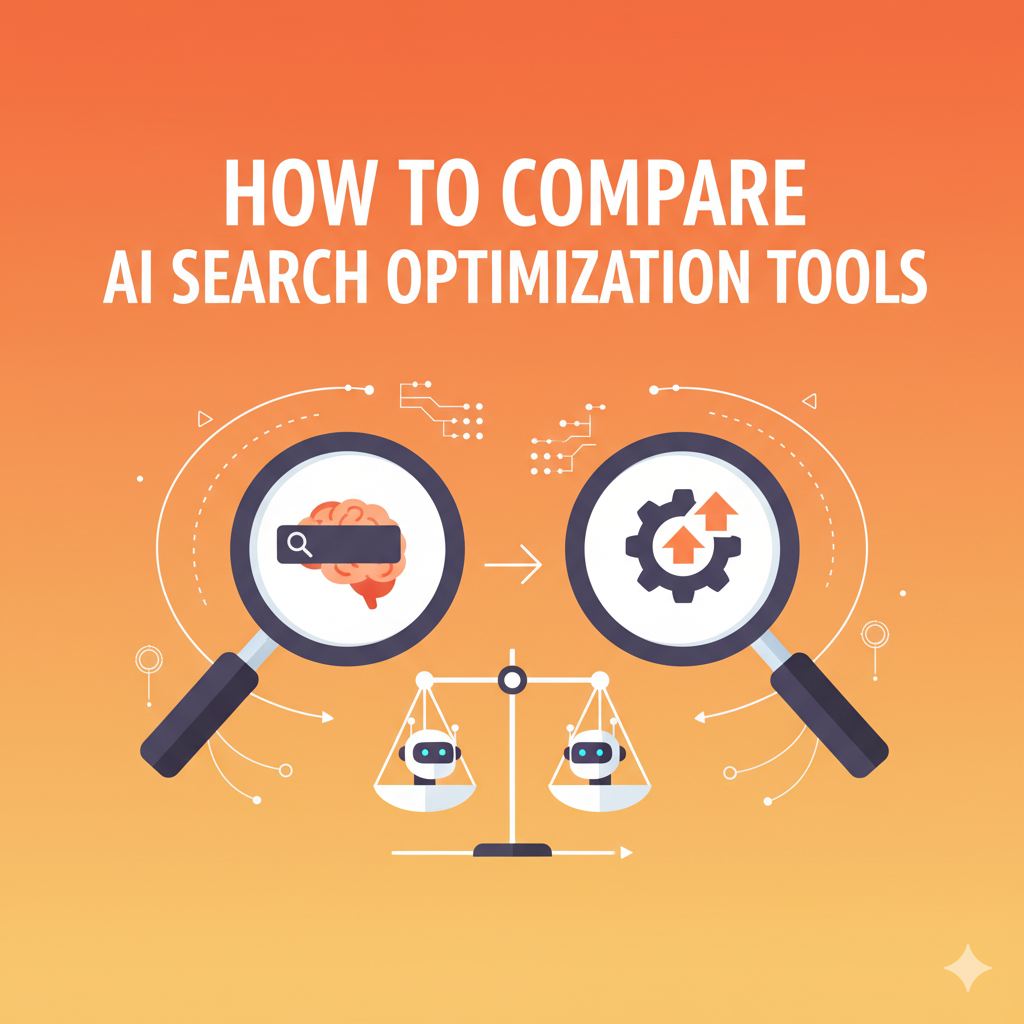To compare AI search-optimization tools effectively, pick a small set of candidate tools, define the real search problems you want to solve (queries, content types, languages, traffic goals), measure them across accuracy, relevance, speed, scalability, integration & workflow fit, cost, and data privacy/compliance, run the same real-world tests (A/B or side-by-side), collect quantitative metrics and qualitative feedback from users, and choose the tool that gives the best balance for your budget and technical constraints. Below I’ll walk you through an actionable, repeatable process I use when evaluating such tools with examples, a comparison checklist, and a sample scoring matrix you can copy.
Why this matters (and how I approach it)
I’ve evaluated search tools for blogs, e-commerce stores, and client projects. The worst decisions I’ve seen come from choosing a vendor based on marketing claims or a single demo. Good selection is about testing with your data and your users not just reading specs. In this post I’ll give a practical, step-by-step method that’s friendly for solo creators or small teams, and that matches the tone and structure I follow on my blog: quick answer first, then detailed steps you can run today.
1. Set the goals you actually care about
Before you compare tools, be specific about what success looks like.
Questions I always answer first (write them down):
- What search problems am I solving? (site search, discovery, related content, knowledge base, product search)
- What metrics matter? (click-through rate (CTR), mean reciprocal rank (MRR), time to result, conversion rate, query latency)
- What types of content? (long-form articles, short help docs, product catalogs, PDFs)
- Are there language or regional needs? (Indian English, Hinglish, multilingual)
- Privacy/compliance constraints? (PHI, PII, GDPR, Indian regulations)
- Budget and team constraints? (developer hours, hosting, maintenance)
Example goal: “Improve on-site article search so that users find a helpful article within the first 3 results at least 60% of the time, while keeping average query latency under 300 ms.”
2. Shortlist candidate tools
Make a short list (3–6 tools). Include established names and one experimental or low-cost option.
How I shortlist:
- Look at recent demos or case studies relevant to your use case.
- Pick 1–2 enterprise offerings, 1–2 mid-market/cloud offerings, and 1 open-source/self-hosted if maintenance is OK.
- Avoid more than 6 for initial tests — too many increases workload.
Example shortlist for article search
- Tool A — cloud AI re-ranking + semantic embeddings.
- Tool B — lightweight vector index + exact match hybrid.
- Tool C — self-hosted open-source vector search.
- Tool D — e-commerce focused (if product search).
3. Prepare a realistic test dataset
Use real content and real queries. Synthetic tests lie.
Steps I use:
- Export a representative set of 1,000–5,000 documents/pages (title, body, metadata, tags).
- Collect real queries from analytics (last 30–90 days). Filter to the top 200–500 distinct queries and include a mix: navigational, informational, transactional, misspellings, and long-tail queries.
- Create a gold standard: for a sample of ~100 queries, manually label the top 5 results you’d want returned (this becomes ground truth for evaluation).
Tip: If you don’t have analytics, ask 10–15 people who represent your users to write 5 queries each, or use common search intents you want to serve.
4. Define objective metrics to measure
Make evaluations repeatable and objective.
My go-to metrics:
- Top-k precision (precision@3 or @5): proportion of relevant items in top k.
- Mean Reciprocal Rank (MRR): how high the first relevant result appears.
- NDCG (Normalized Discounted Cumulative Gain): rewards higher positions for more relevant items.
- Latency (p95): 95th percentile response time.
- Throughput / QPS: if you expect heavy traffic.
- Cost per 1M queries or cost per month for expected usage.
- Developer time to integrate (hours).
- Indexing time (per 1k documents).
- False positive / hallucination rate for generated answers (if tool synthesizes answers).
Qualitative metrics:
- Relevance quality for ambiguous queries.
- Handling of misspellings and abbreviations.
- Rich result support (snippets, highlighted passages).
- Admin and analytics UX (are logs easy to read?).
5. Run identical tests (same queries, same data)
This is the most important step.
How I run them:
- Load the same dataset into each tool following vendor docs.
- Use the same query set and measure responses.
- For re-ranking or generative layers, test both “raw results” and “with re-ranker” settings.
- Run baseline tests (exact match only) to understand improvement margins.
Practical tip: Automate the test harness. A simple script that hits each tool’s API, records the top 10 results, latency, and response size will save time and ensure fairness.
6. Score and compare — create a matrix
Turn measurements into a single comparison view.
Sample scoring approach (0–5 scale for each criterion):
- Accuracy / relevance: based on precision@3 and MRR.
- Latency: based on p95 thresholds you set.
- Cost: map to expected monthly cost.
- Integration effort: hours estimated.
- Privacy & compliance: 0 (no) to 5 (meets required compliance).
- Features (semantic, typo handling, analytics): 0–5.
Multiply weight by importance. For example, if relevance is twice as important as latency, give it weight 2.
Example (simplified):
| Tool | Relevance (x2) | Latency (x1) | Cost (x1) | Integration (x1) | Privacy (x1) | Total |
|---|---|---|---|---|---|---|
| A | 4→8 | 3 | 2 | 3 | 4 | 20 |
| B | 3→6 | 4 | 4 | 4 | 3 | 21 |
| C | 2→4 | 2 | 5 | 2 | 5 | 18 |
Pick the highest practical score considering long-term maintainability.
7. Validate with real users (qualitative testing)
Numbers are essential, but human perception matters.
What I test with users:
- Run an A/B test on live search (if possible) for 2–4 weeks.
- Show testers search results and ask them to rate usefulness, trust, and speed.
- Track downstream metrics (bounce rate after search, conversion, time on page).
Small example test: Replace your current search on a small percent (10–20%) of users with Tool B’s results and compare CTR and task completion versus the control.
8. Consider non-technical factors
These often decide the final pick.
- Vendor support & SLAs: How responsive is support? Are there uptime guarantees?
- Roadmap: Are they investing in features you’ll need (multilingual, vector compression, etc.)?
- Community & docs: Good docs speed integration.
- Lock-in: How easy is migration away later? Open formats and export options matter.
- Security: Encryption at rest/in transit, VPC options, audit logs.
9. Special considerations for AI-driven features
If tools use LLMs to synthesize answers, evaluate these extra risks:
- Hallucination frequency: How often does the model invent facts?
- Attribution & source linking: Does the tool provide provenance (source links) for generated snippets?
- Customization: Can you control prompts and answer style?
- Cost of generated tokens: Generative layers often increase per-query cost significantly.
In my experience, for knowledge bases and help centers, I prefer a hybrid: use retrieval for candidate passages and only synthesize a short answer with clear source links. That reduces hallucination and keeps users trusting results.
10. Make the final decision and plan rollout
Choose the tool that best balances relevance, cost, and maintenance. Then plan:
- Pilot: 2–4 week pilot on a subset of traffic.
- Monitor: set dashboards for the earlier metrics (precision@3, latency, CTR).
- Iteration: tune ranking signals, synonyms, and boosting rules in weeks 2–8.
- Fallback: maintain a plan to revert to old search if issues appear.
Quick actionable checklist (copy & use)
- Define primary search use case and success metrics.
- Export 1k–5k representative documents.
- Collect 200–500 real queries and pick 100 for gold labeling.
- Shortlist 3–6 tools (enterprise, mid, open).
- Create automated harness to run identical queries against each tool.
- Measure precision@3, MRR, NDCG, p95 latency, costs, indexing time.
- Run small user qualitative test (10–30 users).
- Score tools with weighted matrix.
- Pilot chosen tool for 2–4 weeks on live traffic.
- Iterate ranking rules and track business KPIs.
Example scoring rubric (copyable)
Weights: Relevance 40%, Latency 15%, Cost 10%, Integration 15%, Privacy 20%.
Score each tool 1–10 for each dimension, multiply by weight, and sum. Pick the highest. I attach a short sample table you can replicate in Google Sheets.
Realistic example from my work
When I replaced a basic keyword search for a knowledge base with a semantic + re-ranking solution, we followed the steps above. We ran the same 200 queries, created a 100-query gold set, and found precision@3 improved from 0.42 to 0.68. Latency increased slightly, but p95 remained under our 300 ms target by tuning caching. User satisfaction (via a short in-search popover survey) rose from 52% helpful to 77% helpful within three weeks. The tradeoff was a higher monthly bill acceptable because support tickets dropped and agent time saved covered the cost.
Common pitfalls and how to avoid them
- Choosing on marketing alone — always test with your data.
- Small or synthetic query sets — make queries representative.
- Ignoring long-tail & misspellings — test these explicitly.
- Not measuring integration cost — a beautiful API is useless if it takes months to integrate.
- Forgetting privacy & compliance — especially important for healthcare, finance, and user data.
Summary: the decision tree I use
- Define goals and constraints.
- Shortlist realistic candidates.
- Test with real content and queries.
- Measure objective and subjective metrics.
- Score with weighted matrix.
- Pilot, monitor, iterate.
If you follow those steps, you’ll avoid common mistakes and choose a tool that truly helps your users not just a vendor that sounds good in a demo.

